Chem 210 reactions - Study guides, Class notes & Summaries
Looking for the best study guides, study notes and summaries about Chem 210 reactions? On this page you'll find 298 study documents about Chem 210 reactions.
Page 4 out of 298 results
Sort by
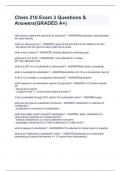
-
Chem 210 Exam 3 Questions & Answers(GRADED A+)
- Exam (elaborations) • 8 pages • 2024
-
Available in package deal
-
 papersbyjol
papersbyjol
-
- $12.49
- + learn more
what factors explain the outcomes of reactions? - ANSWERhybridization, delocalization, eN, atom density what is a leaving group? - ANSWER- group of atom(s) that can be stable on its own - eN atoms that are good LG also make strong acids what is the α carbon? - ANSWERC directly attached to leaving group what are β Cs? β Hs? - ANSWERβC: C(s) attached to α carbon βH: H(s) attached to βC what is a LB? is it a nucleophile or electrophile? - ANSWERlewis base, nucleophile what i...
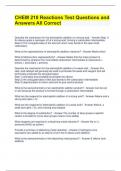
-
CHEM 210 Reactions Test Questions and Answers All Correct
- Exam (elaborations) • 3 pages • 2024
-
Available in package deal
-
PerfectAPass
-
- $8.49
- + learn more
CHEM 210 Reactions Test Questions and Answers All Correct Describe the mechanism for the electrophilic addition of a strong acid. - Answer-Step 1) An alkene grabs a hydrogen off of a strong acid, forming a carbocation intermediate. Step 2) The conjugate base of the acid (an anion now) bonds to the open shell carbocation What is the regioselectivity of electrophilic addition reactions? - Answer-Markovnikov What is Markovnikov regioselectivity? - Answer-States that the major product is d...
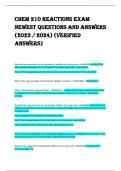
-
CHEM 210 REACTIONS EXAM NEWEST QUESTIONS AND ANSWERS (2023 / 2024) (VERIFIED ANSWERS)
- Exam (elaborations) • 15 pages • 2024
-
 MUNYIDOC
MUNYIDOC
-
- $17.99
- + learn more
What is the degree of substitution? <<ANSWERS>>>The number of alkyl groups a specific carbon is bonded to (more alkyl groups means more stable) What reagents are required in a dissolving metal reduction? <<ANSWERS>>>Na or Li, ammonia (NH3) as solvent Provide a summary of dissolving metal reduction <<ANSWERS>>>2 hydrogens (one equivalent) are added to an alkyne to form the E alkene (anti addition) What is the stereochemistry of the dissolving ...
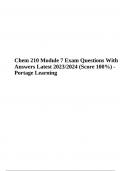
-
Chem 210 Module 7 Exam Review Questions With Answers Latest 2023/2024 (Verified)
- Exam (elaborations) • 14 pages • 2023
-
 STUDYCENTER2024
STUDYCENTER2024
-
- $15.49
- + learn more
Chem 210 Module 7 Exam Review Questions With Answers Latest 2023/2024 (Verified) In glycolysis, when glucose enters a cell, it is immediately phosphorylated to form glucose-6-phosphate. The phosphate donor in this reaction is ATP, and the enzyme is ________. Hexokinase Aldolase CoA Phosphohexose isomerase None of the above HEXOKINASE Question 10 3 / 3 pts In the last reaction of glycolysis, ATP is formed by the direct transfer of a phosphate group from a metabolite to ADP. This...
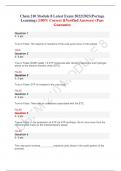
-
Chem 210 Module 8 Latest Exam 2022/2023(Portage Learning) (100% Correct &Verified Answers) (Pass Guarantee
- Exam (elaborations) • 11 pages • 2023
-
Available in package deal
-
 PurityKauri
PurityKauri
-
- $14.49
- + learn more
Chem 210 Module 8 Latest Exam 2022/2023(Portage Learning) (100% Correct &Verified Answers) (Pass Guarantee True or False: The majority of reactions of the urea cycle occur in the cytosol. TRUE True or False: NADH yields 1.5 ATP molecules after donating electrons and hydrogen atoms to the electron transfer chain (ETC). FALSE True or False: GTP is invested in the urea cycle. FALSE True or False: There are six complexes associated with the ETC. FALSE True or False: In the p...
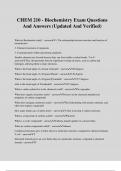
-
CHEM 210 - Biochemistry Exam Questions And Answers (Updated And Verified)
- Exam (elaborations) • 3 pages • 2024
-
 Fyndlay
Fyndlay
-
- $10.49
- + learn more
CHEM 210 - Biochemistry Exam Questions And Answers (Updated And Verified) What do Biochemists study? - answer1. The relationship between structure and function of biomolecules 2. Chemical reactions of organisms 3. Communication within and among organisms Smaller elements are favored because they can form stable covalent bonds. T or F - answerTrue. Strong bonds form by significant overlap of atoms, such as carbon and hydrogen, allowing them to share electrons. What is the bond angle of a...

-
PORTAGE LEARNING CHEM 210 - MODULE 8 EXAM.
- Exam (elaborations) • 13 pages • 2023
-
 consultant001
consultant001
-
- $13.00
- + learn more
PORTAGE LEARNING CHEM 210 - MODULE 8 EXAM.True or False: The majority of reactions of the urea cycle occur in the cytosol. TRUE True or False: NADH yields 1.5 ATP molecules after donating electrons and hydrogen atoms to the electron transfer chain (ETC). FALSE True or False: GTP is invested in the urea cycle. FALSE True or False: There are six complexes associated with the ETC. FALSE True or False: In the production of ATP via ATP synthase, the H+ ions move from the mitochondrial matrix ...
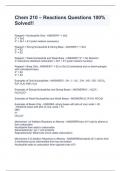
-
Chem 210 – Reactions Questions 100% Solved!!
- Exam (elaborations) • 6 pages • 2024
-
Available in package deal
-
 papersbyjol
papersbyjol
-
- $11.99
- + learn more
Reagent = Nucleophile Only - ANSWER1° = Sn2 2° = Sn2 3° = Sn1 + E1 (polar medium necessary) Reagent = Strong Nucleophile & Strong Base - ANSWER1° = Sn2 2° = E2 3° = E2 Reagent = Weak Nucleophile and Weak Base - ANSWER1°/2° = No Reaction 3°/resonance stabilized carbocation = Sn1 + E1 (polar medium necessry Reagent = Base Only - ANSWER1° = E2 or Sn2 (if unhindered and no beta-hydrogen with unhindered base) 2° = E2 3° = E2 Examples of Only Nucleophiles - ANSWERCl⁻, ...
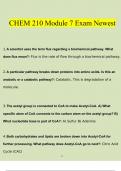
-
CHEM 210 Module 7 Exam Newest
- Exam (elaborations) • 14 pages • 2024
-
 reagandave
reagandave
-
- $10.49
- + learn more
CHEM 210 Module 7 Exam Newest 1. A scientist uses the term flux regarding a biochemical pathway. What does flux mean?: Flux is the rate of flow through a biochemical pathway. 2. A particular pathway breaks down proteins into amino acids. Is this an anabolic or a catabolic pathway?: Catabolic. This is degradation of a molecule. 3. The acetyl group is connected to CoA to make Acetyl-CoA. A) What specific atom of CoA connects to the carbon atom on the acetyl group? ...
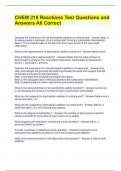
-
CHEM 210 Reactions Test Questions and Answers All Correct
- Exam (elaborations) • 3 pages • 2024
- Available in package deal
-
 MasterGradeVerified
MasterGradeVerified
-
- $8.49
- + learn more
CHEM 210 Reactions Test Questions and Answers All Correct Describe the mechanism for the electrophilic addition of a strong acid. - Answer-Step 1) An alkene grabs a hydrogen off of a strong acid, forming a carbocation intermediate. Step 2) The conjugate base of the acid (an anion now) bonds to the open shell carbocation What is the regioselectivity of electrophilic addition reactions? - Answer-Markovnikov What is Markovnikov regioselectivity? - Answer-States that the major product is d...

Did you know that on average a seller on Stuvia earns $82 per month selling study resources? Hmm, hint, hint. Discover all about earning on Stuvia


